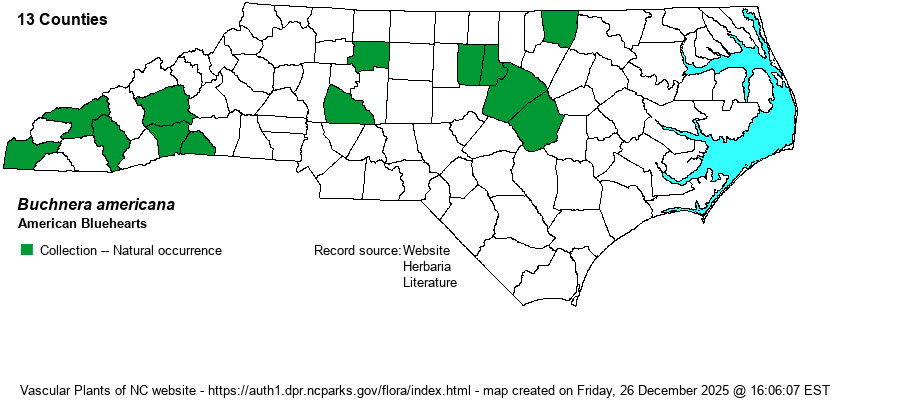| Author | L. | |
| Distribution | Very widely scattered over the Mountains and Piedmont. A few reports or records from the Coastal Plain probably refer to the similar Buchnera floridana, a primarily Coastal Plain species. Some references, such as the BONAP map, consider both of these as the same species; thus, the BONAP map is incorrect for B. americana.
This is a mostly Eastern species, but strongly declining in most of the Eastern states. It ranges from NY west to MI, and south to central NC, the FL Panhandle and then west to TX. | |
| Abundance | Despite it being collected or reported from at least 13 counties, only two such reports have occurred since 1990, including a sizable population in Cherokee County. It is a very rare and clearly declining species in NC, with the decline probably owing to fire suppression. Not surprisingly, and deservedly, it is a State Endangered species. In fact, it is clearly declining throughout much or most of its global range. | |
| Habitat | This species requires high pH soil, and in much of its range is a species of prairies and various glades and barrens, in thin soil. In NC, it is found in sunny and dry to mesic open places, over high pH soil -- powerline clearings, meadows, and glady openings and edges of dry woods. |
| Phenology | Blooms from June to September, and fruits from August to October. | |
| Identification | This is a mostly unbranched herb, reaching about 2 feet tall. The paired (opposite) leaves are mostly limited to the lower half of the stem, and these are essentially sessile, narrowly elliptic to lanceolate, about 3 inches long and 1-inch wide, with a few small teeth along the margins. The top 3-6 inches of the stem contain the compact inflorescence of medium-sized light purplish-blue flowers, each with a slender tube and 5 flaring and spreading petals that are obovate in shape with a squared apex, with the open flower about 1/2-inch across. The flower color can be quite variable within a population, from lavender-purple to lavender-blue to an almost pure blue. But, not many species that bloom in the summertime in meadows or glades have small clusters of light blue flowers. You must take great care in separating this very rare species from the more numerous but essentially Coastal Plain B. floridana. That species has leaves that are wider beyond the middle (as opposed to wider slightly closer to the base in B. americana); leaves that are rounded at the tip (as opposed to tapering); lower leaves with one major vein and two minor ones (versus 3 major and 2 minor ones); teeth of the leaves mostly crenate/rounded (as opposed to somewhat sharp); and it has somewhat smaller flowers (spread flower about 2/5-inch across as opposed to about 1/2-inch). Lastly, B. floridana grows mostly in pine flatwoods, grassy but "savanna-like" roadsides, and other similar places on the Coastal Plain, in soils that are acidic. | |
| Taxonomic Comments | As mentioned above, some references consider B. floridana to be a part of B. americana. Weakley (2018), RAB (1968), and many others consider both as valid.
| |
| Other Common Name(s) | Prairie Bluehearts, Plains Bluehearts | |
| State Rank | S1 | |
| Global Rank | G5? | |
| State Status | E | |
| US Status | | |
| USACE-agcp | FAC link |
| USACE-emp | FACU link |

